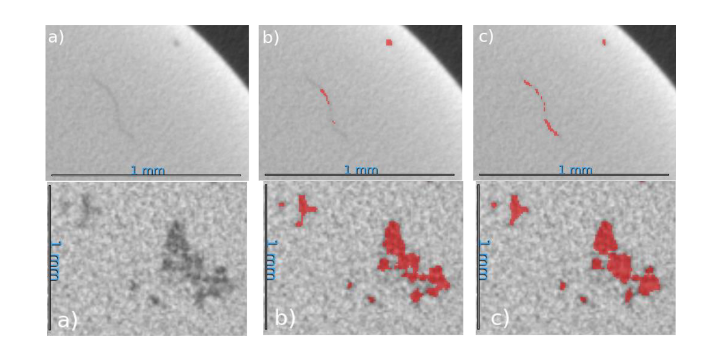Hybrid Modeling of Material Imperfection Indications in X-ray Computed Tomography Datasets
Written by: Erik Lindgren, Fabian Hanning, and Linda Squillaci Published on:
Published on: Summary
Machine learning, more specifically Deep Learning models, have shown remarkable potential for analyzing 3D CT data within both material science and NDT applications. However, the models require large amounts of training data, especially Deep Learning models. Because high quality real experimental data is expensive to derive, humans annotating, synthetic training data is often utilized. In this work we have explored if training data can be modeled with a hybrid approach; where material imperfection indications are transformed directly into real experimental 3D CT reconstructions from 2D and 3D binary representations at higher contrast and resolutions, skipping the usual synthetic dataset derivation steps of reconstructing from simulated 2D projections. Such representations are often abundant from process-development and can be re-used this way for NDT activities. The simple transformations are derived using existing X-ray imaging models (gVXR) and reconstruction algorithms, the FDK in ASTRA Toolbox. We have limited our study to Metal Additively Manufactured samples, Ti-6Al-4V built using Power Bed Fusion Laser Beam process, and superalloy Hastelloy X built with Directed Energy Deposition Laser Beam powder. We demonstrate realistic looking training data sampled with transformation operations low on computational resources. The high-resolution imperfection data is derived both from real experimental data (lack-of-fusion) as well synthetically from other unrelated imaging modalities (lack-of-fusion) as well as from parametric statistical models of superalloy cracks. We believe that the proposed simple and convenient dataset derivation approach, for both Machine Learning training as well as conventional segmentation algorithm parameter optimization, can be valuable to the X-ray NDT community.
Publication
- Erik Lindgren, Fabian Hanning, and Linda Squillaci (2025, Jul). Hybrid Modeling of Material Imperfection Indications in X-ray Computed Tomography Datasets. 10th International Symposium on Digital Industrial Radiology and Computed Tomography, 1 – 3 July 2025 in Paris, France (DIR 2025). e-Journal of Nondestructive Testing Vol. 30(8). doi:10.58286/31443 .
Citation
@article{Lindgren2025DIR,
author = {Lindgren, E. and Hanning, F.and Squillaci, L.},
year = 2025,
title = {Hybrid Modeling of Material Imperfection Indications in {X-ray} Computed Tomography Datasets},
journal = {e-Journal of Nondestructive Testing},
voume = 30,
number = 8,
doi = {10.58286/31443},
note = {10th International Symposium on Digital Industrial Radiology and Computed Tomography, 1-3 July 2025 in Paris, France.}
}